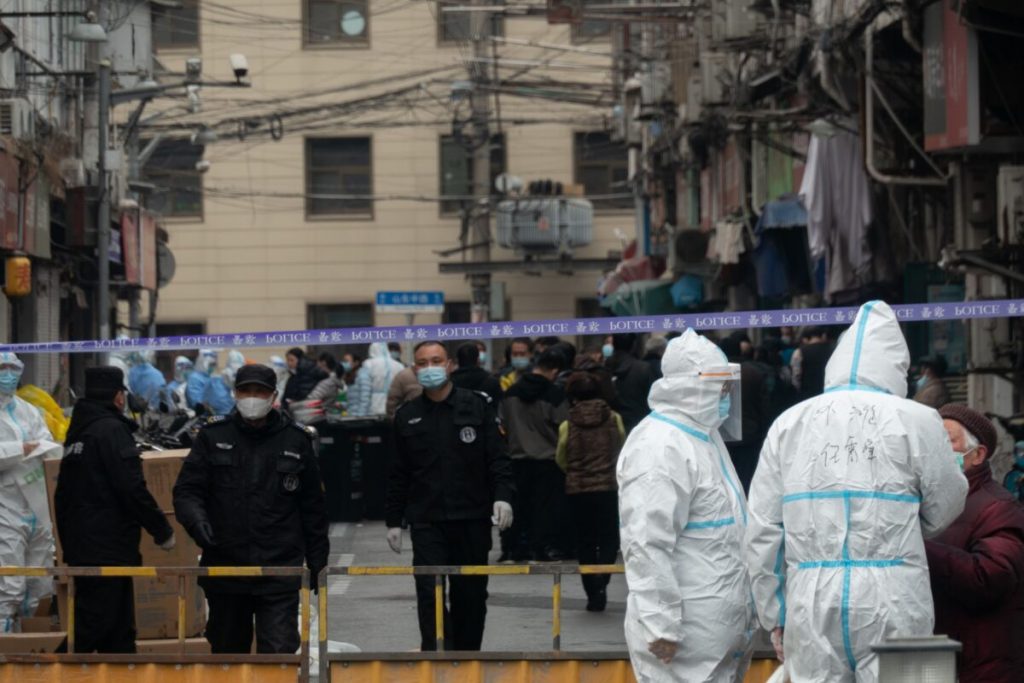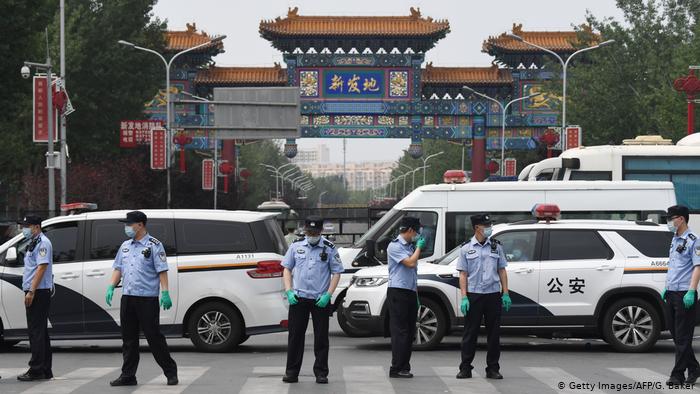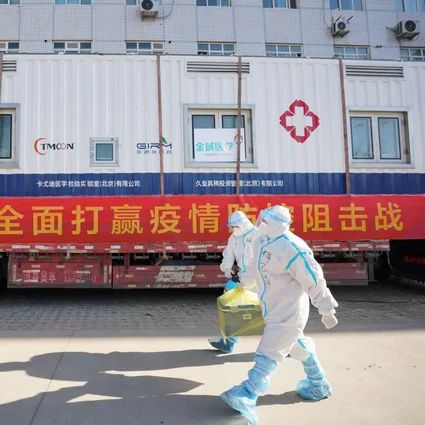
- A countrywide COVID-19 outbreak has resulted in the shut down of at least 11 regions as of January 22.
- China has officially claimed only a few cases but the extensive lockdown measures in several cities and far away villages uncovers the true extent of the latest surge
- As per the new quarantine rules, people within China who live in areas designated as medium or high risk for contracting the virus are not allowed to enter Beijing.
- CCP authorities relocated about 20,000 people in Shijiazhuang, the capital of Hebei Province, to other areas for quarantine several days ago.
- In order to prevent the spread of the disease into Beijing, 300,000 migrant workers living in the neighboring town of Yanjiao were recently banned from entering the capital city.
- Chinese social media users have criticized the decision to implement strict lockdown measures which are affecting the daily lives of people, has resulted in soaring food prices and immense loss of livelihoods
On January 20, two more Chinese cities went under lockdown, as Beijing mandates 4-Week quarantine for travelers between various provinces. While China officially claims that it has detected ‘only 7’ cases of COVID-19 in Beijing and few cases in other cities, the extensive lockdown measures in several cities and far away villages reveal the true extent of the latest surge, believe experts.
A countrywide COVID-19 outbreak has resulted in the shut down of at least 11 regions as of today. The CCP (Chinese Communist Party) backed Global Times newspaper on Jan. 18 reported that 11 Chinese regions are under “de facto lockdown” amid virus infections. “Northeast China’s Heilongjiang sealed off at least five regions – Zhaodong, Qinggang, Suihua city’s downtown area, Angangxi district in Qiqihar, and Hulan district in Harbin. Local residents are required to stay in their homes and vehicles are prohibited on roads. Exit and entry roads are also closed off,” the paper said.
Two more cities in northeastern Jilin Province went under lockdown on January 21, as authorities in two villages in Heilongjiang Province culled all livestock—fearing that animals could also spread the virus. Spokesman for the Beijing city government Xu Hejian announced new rules to control the epidemic. At a daily press conference, Hejian said Beijing and other cities have detected people from overseas who tested positive for COVID-19 after their 14-day quarantine. With detection of new cases in Shanghai, the entire financial hub of China is expected to go under lockdown if many more cases are reported in the coming days.
As per the new quarantine rules, people within China who live in areas designated as medium or high risk for contracting the virus are not allowed to enter the capital. Anyone who wishes to do so must apply for special approval from the Beijing government. If they are approved, they and the Beijing residents they will interact with must complete the four-week quarantine. Experts believe that such strict quarantine measures are mandated only if hundreds of cases have been detected and the CCP wishes to hide them from their own public and from scrutiny of the world.
Official data hides the truth

CCP authorities relocated about 20,000 people in Shijiazhuang, the capital of Hebei Province, to other areas for quarantine several days ago. The outbreak, according to officials, also spread to Qiqihar—one of the largest cities in northern China in Heilongjiang Province. The new wave of the COVID-19 outbreak in Shijiazhuang was concentrated in the Zengkun township of Gaocheng district and has spread to other parts of China. Heilongjiang Province has officially reported 448 confirmed cases of COVID-19 as of Jan. 18, but the public believes that the actual situation is much worse than the official data.
Leaked government documents obtained by The Epoch Times showed that officials in Hebei are anticipating a surge in COVID-19 cases and are making preparations to curb its spread. Chinese officials in Heilongjiang Province on Jan. 14 told all 38 million residents to self-quarantine at home, although they didn’t specify the duration of the quarantine.
Apart from major regions, the severity of the recent surge of COVID-19 infections in Qiqihar, the second largest city in China’s northeastern Heilongjiang Province, has been concealed by officials, locals say. The Epoch Times interviewed Qiqihar residents on Jan. 18 and learned that the city has been locked down since last week, and many residential buildings were sealed off by authorities as part of measures to curb the spread of the COVID-19 virus. Ang’angxi district of Qiqihar has been under lockdown since Jan. 12 after three residents tested positive for COVID-19. All three returned from Wangkui county, the epicenter of the latest round of the COVID-19 outbreak in Heilongjiang Province. Four of their close contacts also tested positive for the virus. These are the only seven cases China has officially claimed.
Locals believe that the epidemic situation in Qiqihar is severe. Local authorities said that there were more than 20 asymptomatic infections, but he surmised that such a large-scale city-wide lockdown contradicted the official data. They say that many residential areas have been closed off and this cannot happen if several cases were not reported. Hundreds of residential buildings and individual homes have been locked down but China has not added them to the official figures of COVID-19 infections. The Epoch Times obtained a video (below) of a sealed residential building in Changxinyuan community in Qiqihar, and a resident was bringing in food from outside with a rope.
Further, Tonghua and Gongzhuling in Jilin also announced that both cities would be fully locked down, meaning no incoming or outgoing transportation would be allowed. In Suihua city, authorities announced that it would adopt “security measures” on two local villages, Lijinghua and Hong Jiatun.
The COVID-19 outbreak in central Hebei Province continues to worsen. In order to prevent the spread of the disease into Beijing, 300,000 migrant workers living in the neighboring town of Yanjiao were recently banned from entering the capital city. In Shijiazhuang city, Hebei Province, one of the hardest-hit areas in the recent virus resurgence, an insider said authorities removed over 20,000 villagers from the Zengcun township because many had COVID-19 as per a Epoch Times report. However, the livestock, poultry, and crops in evacuated villages, were all left behind.
Strict Lockdown and Quarantine rules

The Chinese authorities have mandated all these towns and villages to care for food supplies and accommodation by themselves. Canteens have canceled dine-in services, and group lodgings are strictly prohibited. Shopping malls are closed, and merchants have been prohibited from offering delivery services.
The latest lockdown measures and strict quarantine rules has the Chinese citizens themselves question the veracity of the official figures. The Chinese regime is known to cover up the figures and release only what it wishes its citizens to see. The plight of the migrant workers and the latest surge in COVID-19 cases was being talked about in the Chinese social media. Several netizens on Weibo have posted about how workers may not get their year-end bonuses and could lose their jobs if they can’t return to work.
Chinese social media users have criticized the decision to implement strict lockdown measures which are affecting the daily lives of people. A video shared on a Chinese social media app, shows that after Yanjiao was locked down, a large number of people were waiting to be let out of a community in the early morning hours of Jan 13. They were upset over the lack of electricity, water, and gas and expressed their anger over the unplanned lockdown.
Though local markets are open, residents have complained that the food prices have increased by 20 to 30 percent. Many people are out of food but they are unable to afford the high costs and many are believed to be going hungry. With the lockdown expected to last several weeks, the residents of these cities and villages are concerned that they may not be able to survive that long and have urged the local authorities to ease restrictions. But the Chinese government is forced to impose the lockdown and may not ease restrictions, say Chinese observers. Though the daily lives of China’s citizens are in doldrums, the CCP and the government are more interested in their image and PR exercise they say.
The official announcements on the COVID-19 outbreak does not mention the reasons for lockdown measures in nearly a dozen cities and hundreds of villages. The official figures do not give the true estimates of the cases and these numbers do not concur with the extensive lockdown and quarantine measures.
